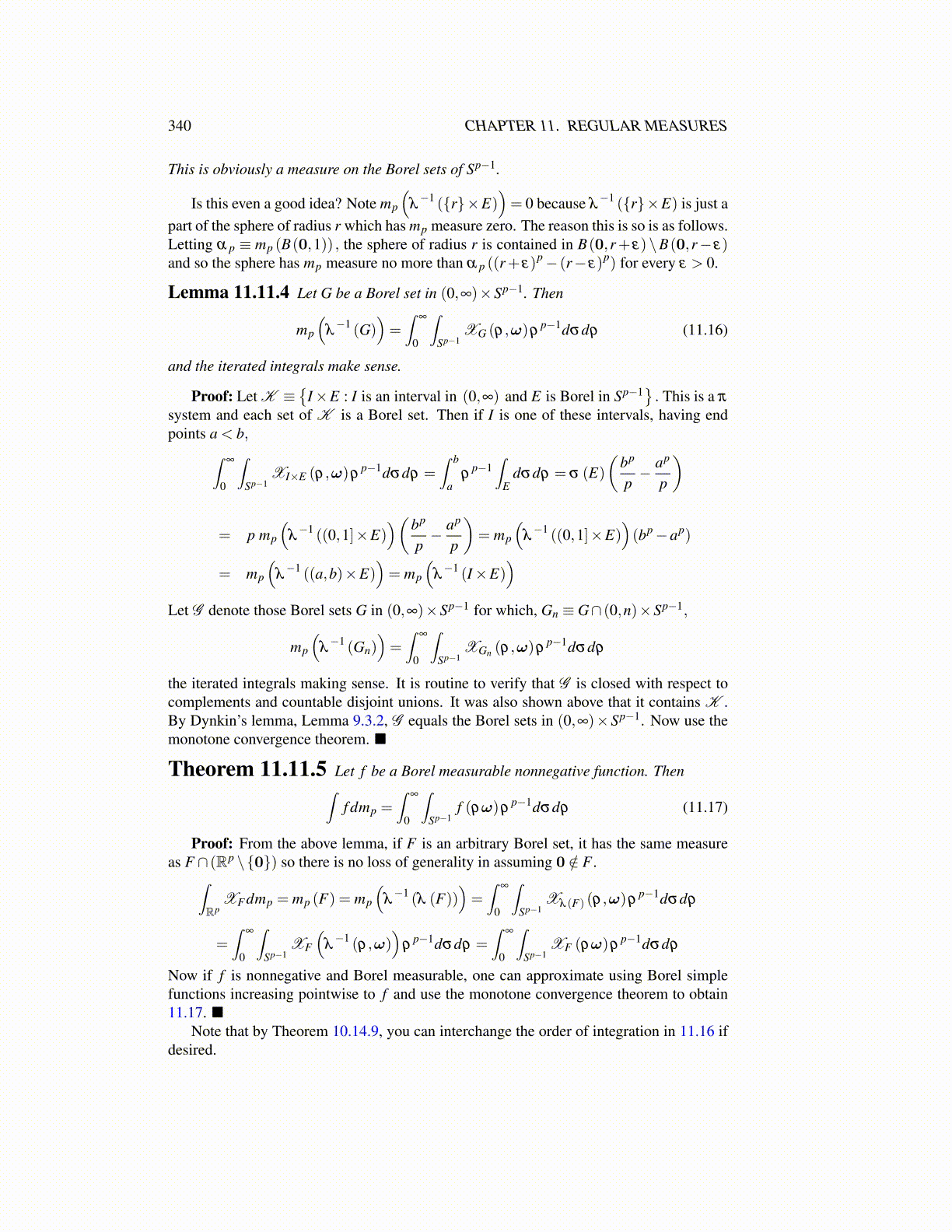
340 CHAPTER 11. REGULAR MEASURES
This is obviously a measure on the Borel sets of Sp−1.
Is this even a good idea? Note mp
(λ−1 ({r}×E)
)= 0 because λ
−1 ({r}×E) is just apart of the sphere of radius r which has mp measure zero. The reason this is so is as follows.Letting α p ≡ mp (B(0,1)) , the sphere of radius r is contained in B(0,r+ ε)\B(0,r− ε)and so the sphere has mp measure no more than α p ((r+ ε)p− (r− ε)p) for every ε > 0.
Lemma 11.11.4 Let G be a Borel set in (0,∞)×Sp−1. Then
mp
(λ−1 (G)
)=∫
∞
0
∫Sp−1
XG (ρ,ω)ρp−1dσdρ (11.16)
and the iterated integrals make sense.
Proof: Let K ≡{
I×E : I is an interval in (0,∞) and E is Borel in Sp−1}. This is a π
system and each set of K is a Borel set. Then if I is one of these intervals, having endpoints a < b,∫
∞
0
∫Sp−1
XI×E (ρ,ω)ρp−1dσdρ =
∫ b
aρ
p−1∫
Edσdρ = σ (E)
(bp
p− ap
p
)
= p mp
(λ−1 ((0,1]×E)
)(bp
p− ap
p
)= mp
(λ−1 ((0,1]×E)
)(bp−ap)
= mp
(λ−1 ((a,b)×E)
)= mp
(λ−1 (I×E)
)Let G denote those Borel sets G in (0,∞)×Sp−1 for which, Gn ≡ G∩ (0,n)×Sp−1,
mp
(λ−1 (Gn)
)=∫
∞
0
∫Sp−1
XGn (ρ,ω)ρp−1dσdρ
the iterated integrals making sense. It is routine to verify that G is closed with respect tocomplements and countable disjoint unions. It was also shown above that it contains K .By Dynkin’s lemma, Lemma 9.3.2, G equals the Borel sets in (0,∞)×Sp−1. Now use themonotone convergence theorem. ■
Theorem 11.11.5 Let f be a Borel measurable nonnegative function. Then∫f dmp =
∫∞
0
∫Sp−1
f (ρω)ρp−1dσdρ (11.17)
Proof: From the above lemma, if F is an arbitrary Borel set, it has the same measureas F ∩ (Rp \{0}) so there is no loss of generality in assuming 0 /∈ F .∫
RpXF dmp = mp (F) = mp
(λ−1 (λ (F))
)=∫
∞
0
∫Sp−1
Xλ (F) (ρ,ω)ρp−1dσdρ
=∫
∞
0
∫Sp−1
XF
(λ−1 (ρ,ω)
)ρ
p−1dσdρ =∫
∞
0
∫Sp−1
XF (ρω)ρp−1dσdρ
Now if f is nonnegative and Borel measurable, one can approximate using Borel simplefunctions increasing pointwise to f and use the monotone convergence theorem to obtain11.17. ■
Note that by Theorem 10.14.9, you can interchange the order of integration in 11.16 ifdesired.